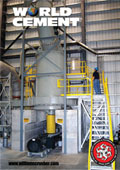Editorial comment
A couple of weeks ago I attended the ECRA Conference on ‘New Cements and Innovative Binder Technologies’ in Barcelona. Featuring presentations from Novacem and Calera alongside the more familiar Schwenk Zement, Lafarge, TU Clausthall and VDZ, it provided an excellent insight into the development of a range of new products, some based on our existing process and others taking an entirely new perspective. The promise of a totally different way of manufacturing cement so that it is either carbon neutral or – even better – carbon negative, has intrigued both the media and investors, but probably neither so much as the roomful of cement VIPs in attendance at the conference. Had I expected to find amongst the delegates a certain degree of cynicism towards these new products, I was mistaken. The response was, in fact, one of genuine interest. I had forgotten that, after all, the majority of the attendees were scientists with a characteristic scientific curiosity.
Register for free »
Get started now for absolutely FREE, no credit card required.
After each presentation came a multitude of questions, and those giving the papers were generous enough to answer openly wherever they could. Of course, it is matters of raw material availability, costs, and commercial scale reproduction of lab experiments that always crop up in such questioning – it was accepted that it is too early in the research for talk of durability and strength, although clearly those were the answers we were all desperate for. In reality, when production capacities of the cements discussed currently range from lab scale to 50 000 tpa, very little has been proven; and especially for the newcomers, Novacem and Calera, energy consumption is an issue. There is clearly no quick fix to the problem of cement’s carbon intensity, but the world at large should be reassured that the industry’s finest minds are working on it! Examples of innovative new cement or concrete mixes can be found on pages 110 to 127 in the article 'Innovations in Sustainable Development', which includes information from some of those companies represented at the conference as well as several others. A brief review of the ECRA event can be found on page 12 and the photos from the conference and preceding plant tour, hosted by Cementos Molins, are on our Facebook page, www.facebook.com/worldcement.
Having been overwhelmed with articles for the Special Environmental Issue last year, WORLD CEMENT scheduled two such issues this year, and this is the second. While the January issue focussed on environmental regulations, emissions monitoring requirements, etc., this issue looks at filtration, dedusting and quarry rehabilitation, with more plant stories and technical articles. As ever, we are very grateful to all those who have contributed, and we look forward to hearing your thoughts on the content: what can be improved, what you would like to see more of, and so on. It’s coming up to the time of year when we prepare next year’s editorial schedule, and your feedback could help shape that. Get in touch with your ideas by emailing me at katherine.markham@worldcement.com.
This month’s Industry Insight focuses on Oceania, while the Regional Report includes articles from Turkey and a look at the cement industry in Egypt and other Mashreq countries in light of recent events. Next month we bring you WORLD CEMENT’s World Review 2011. If you’re not yet a subscriber, sign up at www.worldcement.com to guarantee you receive this incredible issue. If you are a subscriber, remember that you can access every issue online at www.worldcement.com up to two weeks ahead of the print date. Contact laura.cowell@worldcement.com to make sure you have your username and password.


